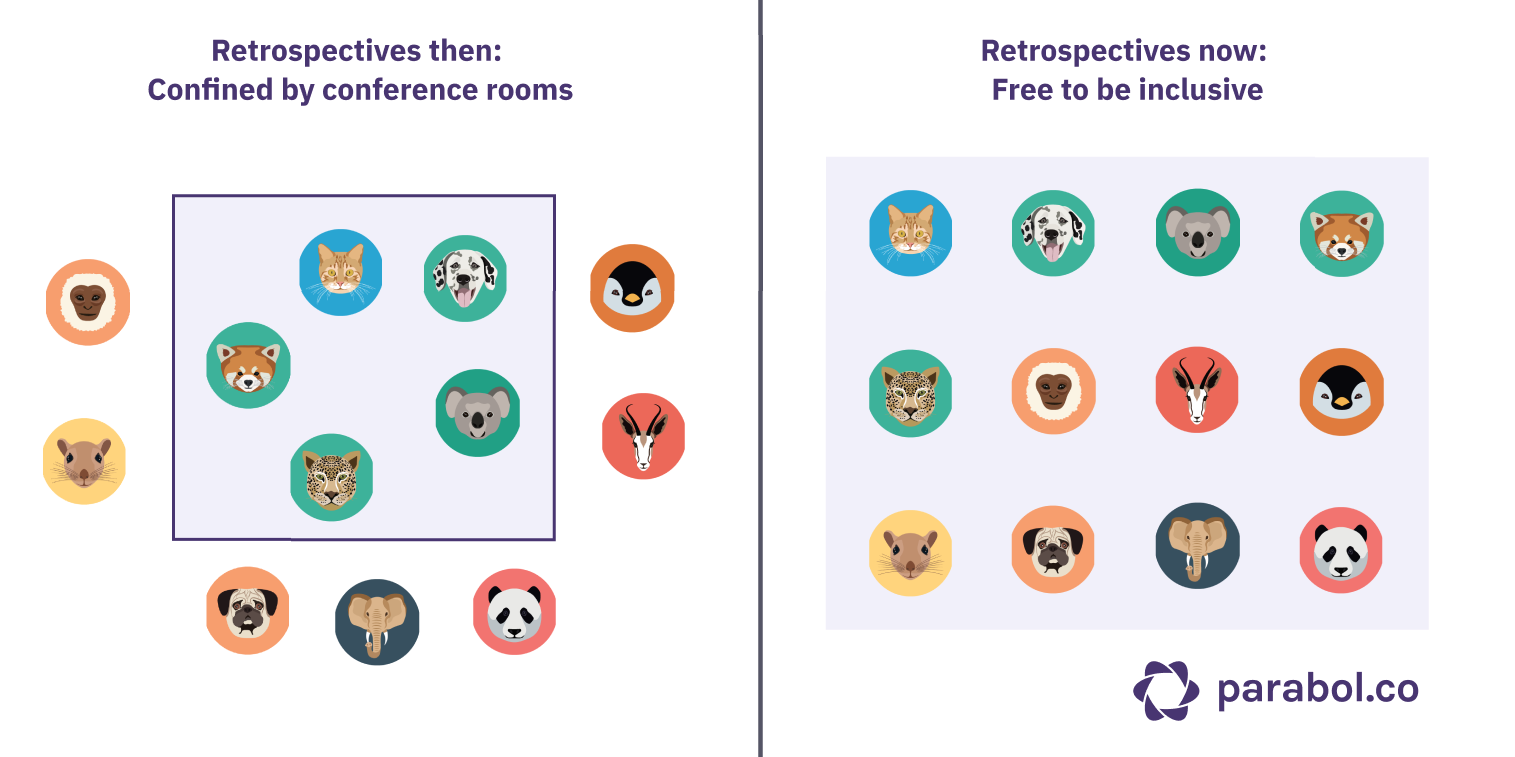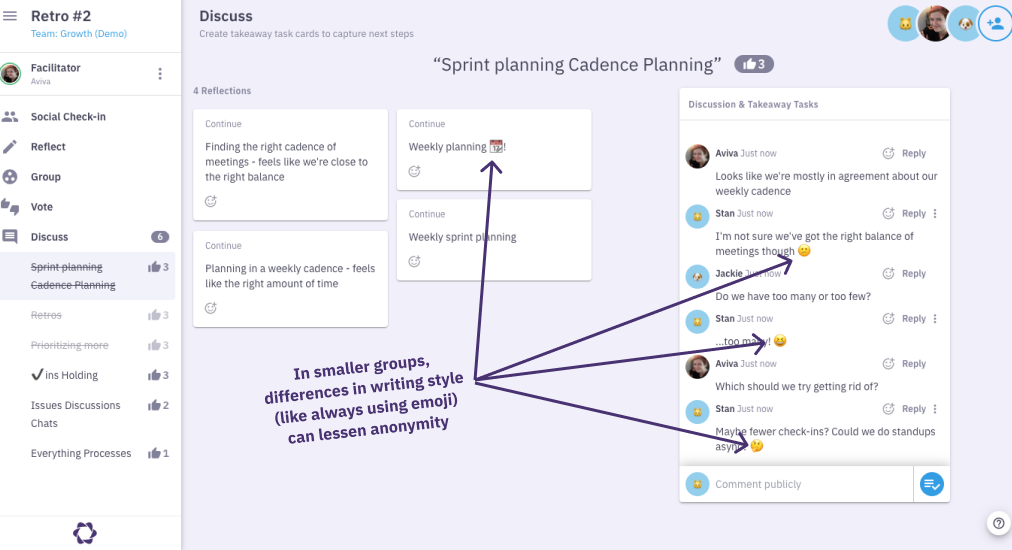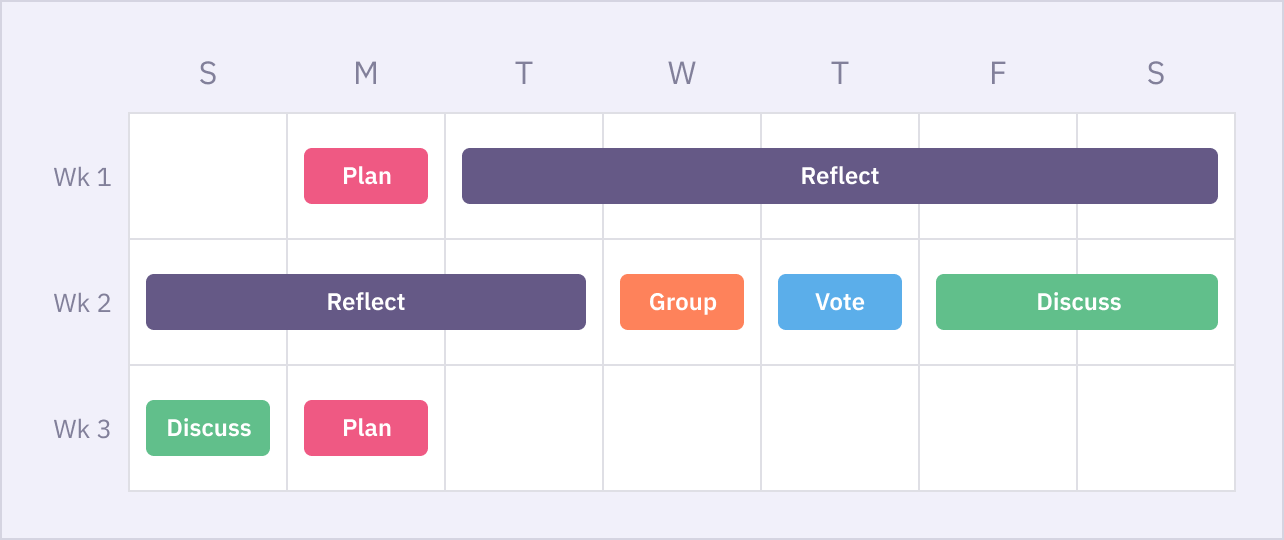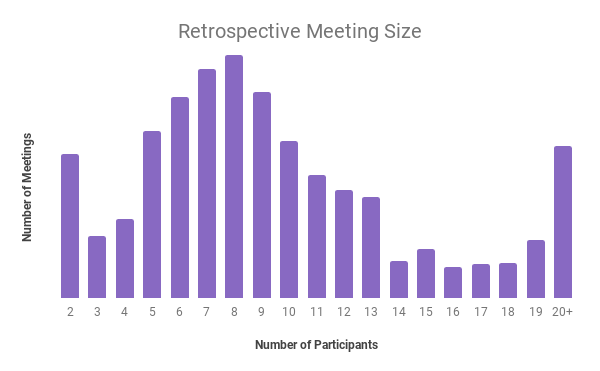5 Easy Tips for Perfectly Sized Remote Retrospectives

With the advent of web conferencing software and shared documents, many of the barriers to running a great agile retrospective are gone:
- An unlimited number of people fit in the room
- An unlimited number of cards are available
- Participants can write, edit, rewrite and move cards to their heart’s content
As we’ve seen first-hand, the kind of multi-player interactions that remote retrospectives allow for can be a meaningful upgrade over the sticky-notes-on-whiteboard retrospectives of the past.
But with so few built-in barriers, sprint retrospectives can feel a bit chaotic, especially if you have too many people in the virtual room.
Inviting the right number of people is key to hosting an effective retrospective. Too many and you risk participants becoming disengaged. Too few and the feeling of anonymity is lost, which means critical tensions may not be voiced.
Picking the right number of participants means everyone feels like the time invested was worthwhile, the takeaways are actionable, and, most importantly, the team grows as a whole.
From our experience building tools and running retros ourselves, finding the right size for your retrospective comes down to considering five important principles.
#1 Effective retrospectives include all stakeholders
When tackling a hard problem, it’s good to see it from different sides. Managing a team is no different, which is why an effective agile retrospective should include as many diverse perspectives as possible. By including all stakeholders, you can decrease tensions before they turn into resentment, increase buy-in for new ideas, and build ownership for new responsibilities.
In the past, a retrospective could only be as big as the conference room. This meant subcontractors, consultants, even clients and employees from other teams were usually left at the door. With online retrospectives, a team lead is free to include everyone who worked on the project.

To generate a list of stakeholders, it’s helpful to think of everyone who was affected by the sprint:
- Start with the core project team. This is probably a group of 2-6 individuals who work across different functions.
- Ask each of them for a shortlist of people they’ve worked with during the sprint.
The result is often surprising and changes from sprint to sprint!
By keeping the guest list fresh, you can guarantee new perspectives will keep discussions interesting. Depending on the relationship, you can even try inviting clients!
While the idea of your client seeing how your team works internally can be daunting, it is also very humanizing. This kind of transparency can start a feedback loop that deepens your relationships and improves the quality of your work together.
In this post-COVID-19 world, we’ve seen pets, partners, and children make guest appearances in video calls. This sneak peek into real life serves as a good reminder that we’re all human, and in many cases can bring compassion to otherwise unruly clients.
By adding clients to your sprint retrospectives, you can get feedback before it’s too late. For overly critical clients, a retrospective serves as a release valve where they can voice frustrations as they occur instead of letting unspoken tensions build resentment. Conversely, certain clients find it difficult to give constructive criticism and default to positivity until the final project has concluded. This usually results in large change requests or a loss of repeat business.
To provide a safe space for constructive criticism, it’s paramount to provide anonymity, which brings us to Tip #2.
#2 Productive agile retrospectives maintain anonymity
After running hundreds of in-person retrospective workshops, one thing is certain: on every team, there is one person who is so good at analyzing handwriting that they could work for the FBI.
In-person, as a team lead, the best you can do to improve anonymity is to make sure everyone has the same color sticky notes and the same pens. Those who go the extra mile might ask everyone to write in all caps which, because it slows writing speed, increases legibility and makes writing look more homogenous.
Even in remote retrospectives, authors can be identified by their writing style (or their use of emojis ).
Unfortunately, all these measures can only accomplish so much in terms of anonymity.
The best way to improve anonymity is to include more participants.
In our own team, after working together for 4 years, we’ve gotten pretty good at identifying each other by writing style. However, we’ve noticed that it becomes exponentially harder to guess correctly when the retrospectives have 6 or more people. More than 10 and it’s darn near impossible!

This is critical because oftentimes the largest, more important, more valuable tensions are the ones that go unspoken. While many managers do a fantastic job of leading by example and providing a space where team members can speak their minds, old habits are hard to change. Individuals coming from difficult ex-employers, notoriously cutthroat industries, or countries with different social norms can find it hard to speak critically about something that could be improved.
This is why we built Parabol to not only anonymize the initial reflections but to also provide a way to discuss delicate topics anonymously. Many teams run a synchronous video call while doing their retro, but we provide the option of anonymous comments on the discussion thread to guarantee all users feel safe contributing.
Discussion threads also allow for more asynchronous discussion, which also make it easier to run powerful retrospectives with a larger team.
#3 Large and international teams struggle with finding the right time – try async retrospectives
In the past, it would be impossible to have a truly all-hands retrospective. Finding the time on every person’s schedule and discussing the hundreds of topics would be overwhelming and far from the best use of everyone’s time. Today, teams can run a retrospective with 60, 80, or even 100+ participants by shifting the process from real-time to asynchronous.
To do so with Parabol, simply set a time limit on each phase of the retrospective. Team members can reflect, group, vote, and discuss on their own schedule. Best of all, the entire conversation is saved and can be revisited at any time.
The asynchronous retrospective works equally well with geographically diverse teams, too.
It’s not uncommon for a product manager in the United States to have a sales team in Europe with a development team in Asia. In the past, an effective sprint retrospective would simply be impossible due to timezone constraints. By providing a response window for each phase there is no limit to the number of participants to invite to your remote retrospective.

#4 Larger teams struggle with engagement – provide more options to interact
Employees who feel engaged in a retrospective are more likely to view it favorably and contribute.
In a conference room, engagement begins to fall off drastically at 6 or more employees, and the same can be true for remote meetings. Paradoxically, this is also where anonymity begins to improve.
This presents a very difficult problem to solve: having fewer participants reduces anonymity, having more participants reduces engagement. While the former limits the quality of initial reflections, the latter affects the quality of discussion.
Therefore, how do we as team leaders increase engagement while increasing the number of participants? The answer is to provide a delightful experience:
- Reflecting should feel safe and anonymous.
- Grouping reflections together should emulate real life where anyone can grab a sticky note and move it anywhere else.
- Discussions should encourage debate and trigger actions to be taken.
- Most importantly, team members should be held accountable for performing the actions they agreed to take.
As your team grows larger and closer, discussions may last longer, which means fewer topics discussed. That is a good problem to have. If the topic reoccurs, it’s likely to be a constant source of tension, and worthy of more time for the next discussion.
#5 To hold effective retros, start small and grow as needed
While online retrospectives have no size limit, there’s no need to go crazy. Start in the range of 6-8 participants and scale up only if engagement stays high. We’ve found this to be the average number of participants.

Of course, if your team is small, don’t feel the need to add people just for the sake of numbers. As trust is earned, anonymity becomes less important and smaller, more intimate retrospectives become possible. In fact, a one-on-one retrospective is more common than a 3 or 4-person retro!
The right size for your retro depends on your team – keep experimenting!
We initially designed Parabol to handle a maximum of 8 participants per meeting thinking surely no team larger than that could stay engaged. Since then, customers have frequently requested the ability to make larger retrospectives possible. While a team of 6-9 participants remains the sweet spot for most, it’s become increasingly more common to see retrospectives with 30 people or more.
To figure out the right number of people for your retrospective, consider:
- Who was involved in this sprint specifically?
- How can we include anyone who might have valuable feedback? Consider options for going async and/or improving anonymity
- Do we have experience running retrospectives? Are we comfortable with a bigger room? If not, consider erring towards a smaller group
By answering these questions, you can bring the right people to the room to have an effective remote retrospective.








